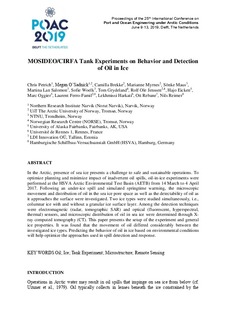| dc.contributor.author | Petrich, Christian | |
| dc.contributor.author | O'Sadnick, Megan Eileen | |
| dc.contributor.author | Brekke, Camilla | |
| dc.contributor.author | Myrnes, Marianne | |
| dc.contributor.author | Maus, Sønke | |
| dc.contributor.author | Salomon, Martina Lan | |
| dc.contributor.author | Woelk, Sofie | |
| dc.contributor.author | Grydeland, Tom | |
| dc.contributor.author | Jenssen, Rolf-Ole Rydeng | |
| dc.contributor.author | Eicken, Hajo | |
| dc.contributor.author | Oggier, Marc | |
| dc.contributor.author | Ferro-Famil, Laurent | |
| dc.contributor.author | Harkati, Lekhmissi | |
| dc.contributor.author | Rebane, Ott | |
| dc.contributor.author | Reimer, Nils | |
| dc.date.accessioned | 2019-09-16T08:17:00Z | |
| dc.date.available | 2019-09-16T08:17:00Z | |
| dc.date.created | 2019-09-09T13:46:19Z | |
| dc.date.issued | 2019 | |
| dc.identifier.citation | Proceedings - International Conference on Port and Ocean Engineering under Arctic Conditions. 2019, 2019-June 1-11. | nb_NO |
| dc.identifier.issn | 0376-6756 | |
| dc.identifier.uri | http://hdl.handle.net/11250/2616896 | |
| dc.description.abstract | In the Arctic, presence of sea ice presents a challenge to safe and sustainable operations. To optimize planning and minimize impact of inadvertent oil spills, oil-in-ice experiments were performed at the HSVA Arctic Environmental Test Basin (AETB) from 14 March to 4 April 2017. Following an under-ice spill and simulated springtime warming, the microscopic movement and distribution of oil in the sea ice pore space as well as the detectability of oil as it approaches the surface were investigated. Two ice types were studied simultaneously, i.e., columnar ice with and without a granular ice surface layer. Among the detection techniques were electromagnetic (radar, tomographic SAR) and optical (fluorescent, hyperspectral, thermal) sensors, and microscopic distribution of oil in sea ice were determined through X-ray computed tomography (CT). This paper presents the setup of the experiment and general ice properties. It was found that the movement of oil differed considerably between the investigated ice types. Predicting the behavior of oil in ice based on environmental conditions will help optimize the approaches used in spill detection and response. | nb_NO |
| dc.language.iso | eng | nb_NO |
| dc.publisher | Port and Ocean Engineering under Arctic Conditions, POAC | nb_NO |
| dc.subject | Mikrostruktur | nb_NO |
| dc.subject | Microstructure | nb_NO |
| dc.subject | Olje i is | nb_NO |
| dc.subject | Oil in ice | nb_NO |
| dc.subject | Tank experiment | nb_NO |
| dc.subject | Fjernmåling | nb_NO |
| dc.subject | Remote sensing | nb_NO |
| dc.title | Mosideo/cirfa tank experiments on behavior and detection of oil in ice | nb_NO |
| dc.type | Journal article | nb_NO |
| dc.type | Peer reviewed | nb_NO |
| dc.description.version | publishedVersion | nb_NO |
| dc.subject.nsi | VDP::Miljøteknologi: 610 | nb_NO |
| dc.subject.nsi | VDP::Environmental engineering: 610 | nb_NO |
| dc.source.pagenumber | 1-11 | nb_NO |
| dc.source.volume | 2019-June | nb_NO |
| dc.source.journal | Proceedings - International Conference on Port and Ocean Engineering under Arctic Conditions | nb_NO |
| dc.identifier.cristin | 1722834 | |
| dc.relation.project | Norges forskningsråd: 243812 | nb_NO |
| dc.relation.project | Norges forskningsråd: 237906 | nb_NO |
| dc.description.localcode | © 2019 Port and Ocean Engineering under Arctic Conditions. Available at http://www.poac.com/PapersOnline.html | nb_NO |
| cristin.unitcode | 194,64,91,0 | |
| cristin.unitname | Institutt for bygg- og miljøteknikk | |
| cristin.ispublished | true | |
| cristin.fulltext | original | |
| cristin.qualitycode | 1 | |
